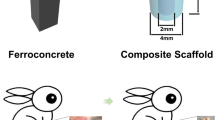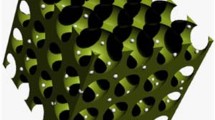Abstract
Treatment of large bone defects (LBDs) is technically demanding. Tissue engineering is an option. A bioactive graft may be produced by combining tissue scaffolds and healing promotive factors in order to accelerate bone repair. We investigated the role of Simvastatin (Sim)-embedded porous Gelapin (Gel) scaffold on experimental bone healing. At first, the effectiveness of different concentrations of Gel and Sim powders was investigated in an experimentally induced femoral hole model in rabbits (n = 6) for 30 days. Then bone bioactive grafts were produced by combination of the effective concentrations of Gel, Sim, and Genipin. The bioimplants were subcutaneously tested in a rabbit model (n = 9) to determine their biocompatibility and biodegradability for 10–30 days. Finally, a large radial bone defect model was produced in rabbits (n = 20), and the bioimplants were inserted in the defects. The untreated and autograft-treated bone defects were served as controls. The animals were euthanized after 30 and 60 days of bone injury. The bone samples were evaluated by radiography, three-dimensional CT scan, bone densitometry, histopathology, and nano-indentation. At a concentration of 5 mg/hole, Sim closed the femoral bone holes after 30 days, while in the defect, autograft, and Gel groups, the holes were open. Both the Gel and Gel–Sim scaffolds were biocompatible and biodegradable. Subcutaneously, the Gel–Sim scaffold was replaced with the newly regenerated ectopic bone after 30 days. After implantation of the Gel–Sim scaffold in the radial bone defects, the scaffold was completely replaced with new woven bone after 30 days which was then matured and remodeled into a cortical bone after 60 days. Sixty days after bone injury, the Gel–Sim-treated defects had significantly higher bone volume, matrix mineralization, elastic modulus, and contact hardness when compared to the controls. The Gel–Sim scaffold may be a suitable option in managing LBDs.







Similar content being viewed by others
References
Oryan A, Alidadi S, Moshiri A (2013) Current concerns regarding healing of bone defects. Hard Tissue 2:13. http://www.oapublishinglondon.com/article/374
Oryan A, Alidadi S, Moshiri A, Maffulli N (2014) Bone regenerative medicine: classic options, novel strategies, and future directions. J Orthop Surg Res 9:18
Moshiri A, Oryan A, Shahrezaee M (2015) An overview on bone tissue engineering and regenerative medicine: current challenges, future directions and strategies. J Sports Med Doping Stud 5:e144. doi:10.4172/2161-0673.1000e144
Kolk A, Handschel J, Drescher W, Rothamel D, Kloss F, Blessmann M, Heiland M, Wolff KD, Smeets R (2012) Current trends and future perspectives of bone substitute materials—from space holders to innovative biomaterials. J Craniomaxillofac Surg 40:706–718
Calvo R, Figueroa D, Díaz-Ledezma C, Vaisman A, Figueroa F (2011) Bone allografts and the functions of bone banks. Rev Med Chil 139:660–666
Moshiri A, Oryan A, Meimandi-Parizi A, Koohi-Hosseinabadi O (2014) Effectiveness of xenogenous-based bovine-derived platelet gel embedded within a three-dimensional collagen implant on the healing and regeneration of the Achilles tendon defect in rabbits. Expert Opin Biol Ther 14:1065–1089
Kirchmajer DM, Watson CA, Ranson M (2013) Gelapin, a degradable genipin cross-linked gelatin hydrogel. RSC Adv 3:1073–1081
Rodriguez IA, Sell SA, McCool JM, Saxena G, Spence AJ, Bowlin GL (2013) A preliminary evaluation of lyophilized gelatin sponges, enhanced with platelet-rich plasma, hydroxyapatite and chitin whiskers for bone regeneration. Cells 2:244–265
Seo JP, Tsuzuki N, Haneda S, Yamada K, Furuoka H, Tabata Y, Sasaki N (2014) Osteoinductivity of gelatin/β-tricalcium phosphate sponges loaded with different concentrations of mesenchymal stem cells and bone morphogenetic protein-2 in an equine bone defect model. Vet Res Commun 38:73–80
Killeen AC, Rakes PA, Schmid MJ, Zhang Y, Narayana N, Marx DB, Payne JB, Wang D, Reinhardt RA (2012) Impact of local and systemic alendronate on simvastatin-induced new bone around periodontal defects. J Periodontol 83:1463–1471
Jiang L, Sun H, Yuan A, Zhang K, Li D, Li C, Shi C, Li X, Gao K, Zheng C, Yang B, Sun H (2013) Enhancement of osteoinduction by continual simvastatin release from poly(lactic-co-glycolic acid)-hydroxyapatite-simvastatin nano-fibrous scaffold. J Biomed Nanotechnol 9:1921–1928
Pullisaar H, Tiainen H, Landin MA, Lyngstadaas SP, Haugen HJ, Reseland JE, Ostrup E (2013) Enhanced in vitro osteoblast differentiation on TiO2 scaffold coated with alginate hydrogel containing simvastatin. J Tissue Eng 4:2041731413515670
Wong RWK, Rabie ABM (2003) Statin collagen grafts used to repair defects in the parietal bone of rabbits. J Oral Maxillofac Surg 41:244–248
Oliveira NM, Correa VB, Chavez VEA (2011) Early alveolar bone regeneration in rats after topical administration of simvastatin. Oral Surg Oral Med Oral Pathol Oral Radiol Endod 112:170–179
Moshiri A, Oryan A, Meimandi-Parizi A (2013) Role of tissue-engineered artificial tendon in healing of a large Achilles tendon defect model in rabbits. J Am Coll Surg 217(421–441):e8
Moshiri A, Oryan A, Meimandi-Parizi A, Silver IA, Tanideh N, Golestani N (2013) Effectiveness of hybridized nano- and microstructure biodegradable, biocompatible, collagen-based, three-dimensional bioimplants in repair of a large tendon-defect model in rabbits. J Tissue Eng Regen Med. doi:10.1002/term.1740
Meimandi-Parizi A, Oryan A, Moshiri A (2013) Tendon tissue engineering and its role on healing of the experimentally induced large tendon defect model in rabbits: a comprehensive in vivo study. PLoS ONE 8:e73016
Chou J, Ito T, Otsuka M, Ben-Nissan B, Milthorpe B (2013) The effectiveness of the controlled release of simvastatin from β-TCP macrosphere in the treatment of OVX mice. J Tissue Eng Regen Med. doi:10.1002/term.1784
Oryan A, Moshiri A, Meimandi-Parizi A (2014) Implantation of a novel tissue-engineered graft in a large tendon defect initiated inflammation, accelerated fibroplasia and improved remodeling of the new Achilles tendon: a comprehensive detailed study with new insights. Cell Tissue Res 355:59–80
Oryan A, Meimandi Parizi A, Shafiei-Sarvestani Z, Bigham AS (2012) Effects of combined hydroxyapatite and human platelet rich plasma on bone healing in rabbit model: radiological, macroscopical, hidtopathological and biomechanical evaluation. Cell Tissue Bank 13:639–651
Parizi AM, Oryan A, Shafiei-Sarvestani Z, Bigham AS (2012) Human platelet rich plasma plus Persian Gulf coral effects on experimental bone healing in rabbit model: radiological, histological, macroscopical and biomechanical evaluation. J Mater Sci Mater Med 23:473–483
Oryan A, Moshiri A, Meimandi-Parizi A (2014) In vitro characterization of a novel tissue engineered based hybridized nano and micro structured collagen implant and its in vivo role on tenoinduction, tenoconduction, tenogenesis and tenointegration. J Mater Sci Mater Med 25:873–897
Oryan A, Moshiri A, Parizi AM, Maffulli N (2014) Implantation of a novel biologic and hybridized tissue engineered bioimplant in large tendon defect: an in vivo investigation. Tissue Eng Part A 20:447–465
Shafiei-Sarvestani Z, Oryan A, Bigham AS, Meimandi-Parizi A (2012) The effect of hydroxyapatite-hPRP, and coral-hPRP on bone healing in rabbits: radiological, biomechanical, macroscopic and histopathologic evaluation. Int J Surg 10:96–101
Oliver WC, Pharr GM (1992) An improved technique for determining hardness and elastic modulus. J Mater Res 7:1564–1583
Sakai M (1999) The Meyer Hardness: a measure for plasticity? J Mater Res 14:3630–3639
Oyen ML (2006) Nanoindentation hardness of mineralized tissues. J Biomech 39:2699–2702
Bala Y, Depalle B, Douillard T, Meille S, Cle´ment P, Follet H, J Chevalier, Boivin G (2011) Respective roles of organic and mineral components of human cortical bone matrix in micromechanical behavior: an instrumented study. J Mech Behav Biomed Mater 4:1473–1482
Ayukawa Y, Yasukawa E, Moriyama Y, Ogino Y, Wada H, Atsuta I, Koyano K (2009) Local application of statin promotes bone repair through the suppression of osteoclasts and the enhancement of osteoblasts at bone-healing sites in rats. Oral Surg Oral Med Oral Pathol Oral Radiol Endod 107:336–342
Anbinder AL, Junqueira JC, Mancini MN, Balducci I, Rocha RF, Carvalho YR (2006) Influence of simvastatin on bone regeneration of tibial defects and blood cholesterol level in rats. Braz Dent J 17:267–273
Skoglund B, Forslund C, Aspenberg P (2002) Simvastatin improves fracture healing in mice. J Bone Miner Res 17:2004–2008
Saraf SK, Singh A, Garbyal RS, Singh V (2007) Effect of simvastatin on fracture healing–an experimental study. Indian J Exp Biol 45:444–449
Thylin MR, McConnell JC, Schmid MJ, Reckling RR, Ojha J, Bhattacharyya I, Marx DB, Reinhardt RA (2002) Effects of simvastatin gels on murine calvarial bone. J Periodontol 73:1141–1148
Zhu J, Song Q, Wang J, Han X, Yang Y, Liao J, Song C (2010) Study on local implantation of simvastatin for repairing rabbit radial critical size defects. Zhongguo Xiu Fu Chong Jian Wai Ke Za Zhi 24:465–471
Chen J, Luo Y, Hong L, Ling Y, Pang J, Fang Y, Wei K, Gao X (2011) Synthesis, characterization and osteoconductivity properties of bone fillers based on alendronate-loaded poly(ε-caprolactone)/hydroxyapatite microspheres. J Mater Sci Mater Med 22:547–555
Ni M, Li G, Tang PF, Chan KM, Wang Y (2011) rhBMP-2 not alendronate combined with HA-TCP biomaterial and distraction osteogenesis enhance bone formation. Arch Orthop Trauma Surg 131:1469–1476
Wu Y, Hou J, Yin M, Wang J, Liu C (2014) Enhanced healing of rabbit segmental radius defects with surface-coated calcium phosphate cement/bone morphogenetic protein-2 scaffolds. Mater Sci Eng C Mater Biol Appl 44:326–335
Zhou P, Xia Y, Cheng X, Wang P, Xie Y, Xu S (2014) Enhanced bone tissue regeneration by antibacterial and osteoinductive silica-HACC-zein composite scaffolds loaded with rhBMP-2. Biomaterials 35:10033–10045
Cao L, Wang J, Hou J, Xing W, Liu C (2014) Vascularization and bone regeneration in a critical sized defect using 2-N,6-O-sulfated chitosan nanoparticles incorporating BMP-2. Biomaterials 35:684–698
Oryan A, Alidadi S, Moshiri A, Bigham-Sadegh A (2014) Bone morphogenetic proteins: a powerful osteoinductive compound with non-negligible side effects and limitations. BioFactors 40:459–481
Boanini E, Torricelli P, Gazzano M, Della Bella E, Fini M, Bigi A (2014) Combined effect of strontium and zoledronate on hydroxyapatite structure and bone cell responses. Biomaterials 35:5619–5626
Fernández JM, Molinuevo MS, McCarthy AD, Cortizo AM (2014) Strontium ranelate stimulates the activity of bone-specific alkaline phosphatase: interaction with Zn(2+) and Mg (2+). Biometals 27:601–607
Li Y, Luo E, Zhu S, Li J, Zhang L, Hu J (2014) Cancellous bone response to strontium-doped hydroxyapatite in osteoporotic rats. J Appl Biomater Funct Mater. doi:10.5301/jabfm.5000168
Lima H, Maia J, Bandeira F (2014) Trajectories of bone remodeling markers and bone mineral density during treatment with Strontium Ranelate in postmenopausal women previously treated with bisphosphonates. Clin Med Insights Endocrinol Diabetes 7:7–11
Rojbani H, Nyan M, Ohya K, Kasugai S (2011) Evaluation of the osteoconductivity of α-tricalcium phosphate, β-tricalcium phosphate, and hydroxyapatite combined with or without simvastatin in rat calvarial defect. J Biomed Mater Res A 98:488–498
Acknowledgments
The authors would like to thank the authorities of AJA University of Medical Sciences for providing the facilitations in performing the present investigation. The kind cooperation of Mr. A. Navideh (Department of Radiology), Mr. M. Chehri (Department of Pathology), Mr. S. Shirzadi (Animal Laboratory center), and Mr. M. Younesi (Department of Radiology, Faculty of Medicine, AJA, University of Medical Sciences, Tehran, Iran) is fully acknowledged.
Conflict of interest
This is the authors’ own work. Dr Ali Moshiri reports that neither conflict of interest nor financial disclosure is present associated with this work or its related contents. Dr Mostafa Shahrezaie reports that neither conflict of interest nor financial disclosure is present associated with this work or its related contents. Dr Babak Shekarchi reports that neither conflict of interest nor financial disclosure is present associated with this work or its related contents. Prof. Ahmad Oryan reports that neither conflict of interest nor financial disclosure is present associated with this work or its related contents. Dr. Kamran Azma reports that neither conflict of interest nor financial disclosure is present associated with this work or its related contents.
Human and Animal Rights and Informed Consent statement
All animals received humane care in compliance with the Guide for Care and use of Laboratory Animals (NIH publication No. 85–23, revised 1985). The study was approved by the local Ethics Committee of AJA University of Medical Science.
Author information
Authors and Affiliations
Corresponding author
Electronic Supplementary Material
Below is the link to the electronic supplementary material.
Rights and permissions
About this article
Cite this article
Moshiri, A., Shahrezaee, M., Shekarchi, B. et al. Three-Dimensional Porous Gelapin–Simvastatin Scaffolds Promoted Bone Defect Healing in Rabbits. Calcif Tissue Int 96, 552–564 (2015). https://doi.org/10.1007/s00223-015-9981-9
Received:
Accepted:
Published:
Issue Date:
DOI: https://doi.org/10.1007/s00223-015-9981-9




